Classful Ip Addressing
Ip addressing is clasified into two forms.
1.classfull addresing
2.classless addressing system(CIDR)
we know ip address is of 32 bits,with 32 bits we will get 2^32 = 4294967296 ip addresses.
we know ip address has two addresses in one address(network address/nid ,host address/hid).
initially they classified it like this.
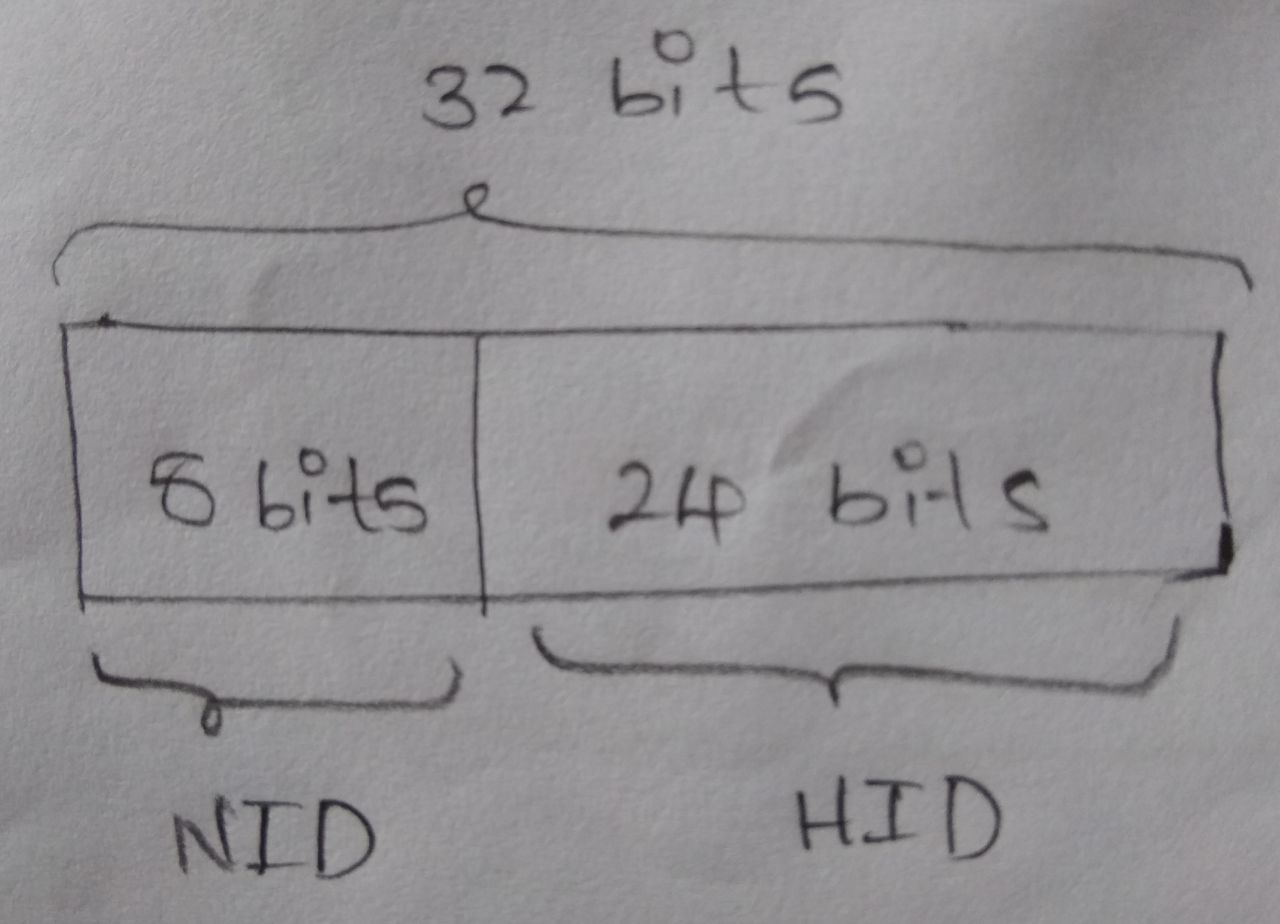
so they divided entire 32 bits into 8 bits for NID,remaining 24 bits for HID.
total networks we get 2^8 = 256.
Total hosts/network 2^24 = 16777216.
256 networks not enough for today,also 16M hosts is very big number,due to this disadvantages classfull addressing come into picture.
classfull classification
In classfull addressing they divided entire ip address space into 5 classes
CLASS A,CLASS B,CLASS C,CLASS D,CLASS E
let’s go through each class
Class A:
so we have address space 32 bits right range
0.0.0.0 to 255.255.255.255
0 0 0 0 0 0 0 0 . 0 0 0 0 0 0 0 0 . 0 0 0 0 0 0 0 0 . 0 0 0 0 0 0 0 0
if we choose one bit in binary the space is divided into 2 parts
Binary Division:
0 0 0 0 0 0 0 0 . 0 0 0 0 0 0 0 0 . 0 0 0 0 0 0 0 0 . 0 0 0 0 0 0 0 0
1 0 0 0 0 0 0 0 . 0 0 0 0 0 0 0 0 . 0 0 0 0 0 0 0 0 . 0 0 0 0 0 0 0 0
now first bit is choosen adn fixed to zero to divided entire address space into two parts,now we have only 31 bits so total addresses in class a we will get is 2^31.
NID,HID Division:
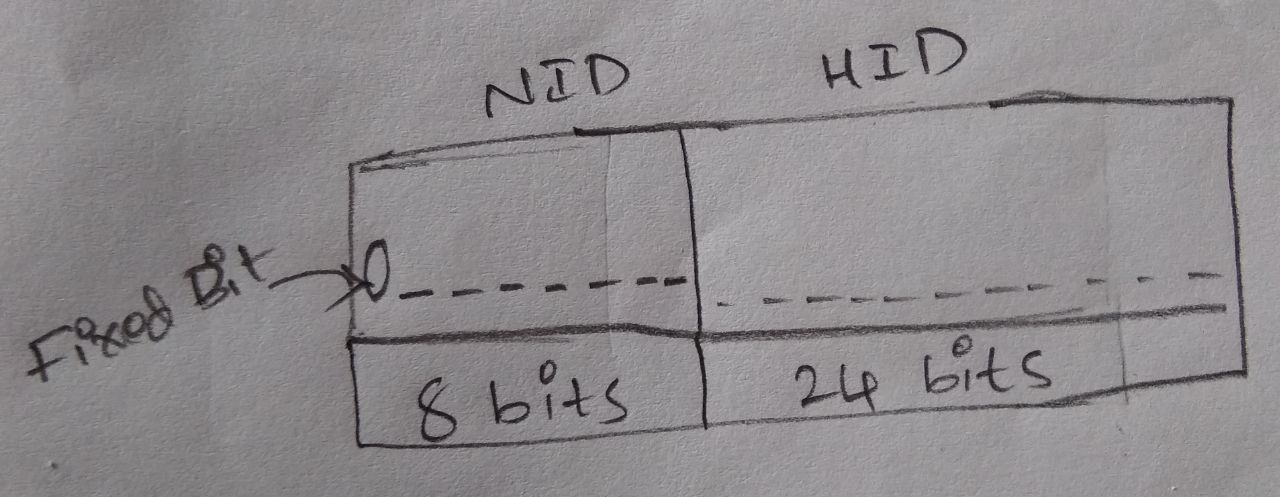
first octet first bit is set to zero so total networks we will get with remaining 7 bits is 2^7=128(practical number 126)
total hosts/network = 2^24
we can configure only 2^24-2 hosts/network
Range:
by seeing first octet if first bit is start from 0 in binary we can say it belongs to class a
by examining first octet we can get range
0 0 0 0 0 0 0 0 - 0
0 0 0 0 0 0 0 1 - 1
0 0 0 0 0 0 1 0 - 2
.
.
.
0 1 1 1 1 1 1 1 - 127
range (0-127)
first network and last network of class a is reseved
practical range can be (1-126)
example ip addresses:1.0.0.0,1.0.0.1,1.0.0.2………..126.255.255.255
this class a ipp addresses used for large networks
Class B:
from previous binary division we got two parts right,lets take remaining part
1 0 0 0 0 0 0 0 . 0 0 0 0 0 0 0 0 . 0 0 0 0 0 0 0 0 . 0 0 0 0 0 0 0 0
first bit is already fixed to 1,by dividing space again into 2 parts we get
1 0 0 0 0 0 0 0 . 0 0 0 0 0 0 0 0 . 0 0 0 0 0 0 0 0 . 0 0 0 0 0 0 0 0
1 1 0 0 0 0 0 0 . 0 0 0 0 0 0 0 0 . 0 0 0 0 0 0 0 0 . 0 0 0 0 0 0 0 0
here we take second bit for division again entire address space is divided into 2 parts
here first two bits are fixed and set to 1 0 ,so the address space contain 30 bits only with 30 bits we will get 2^30 addresses
NID,HID Division:
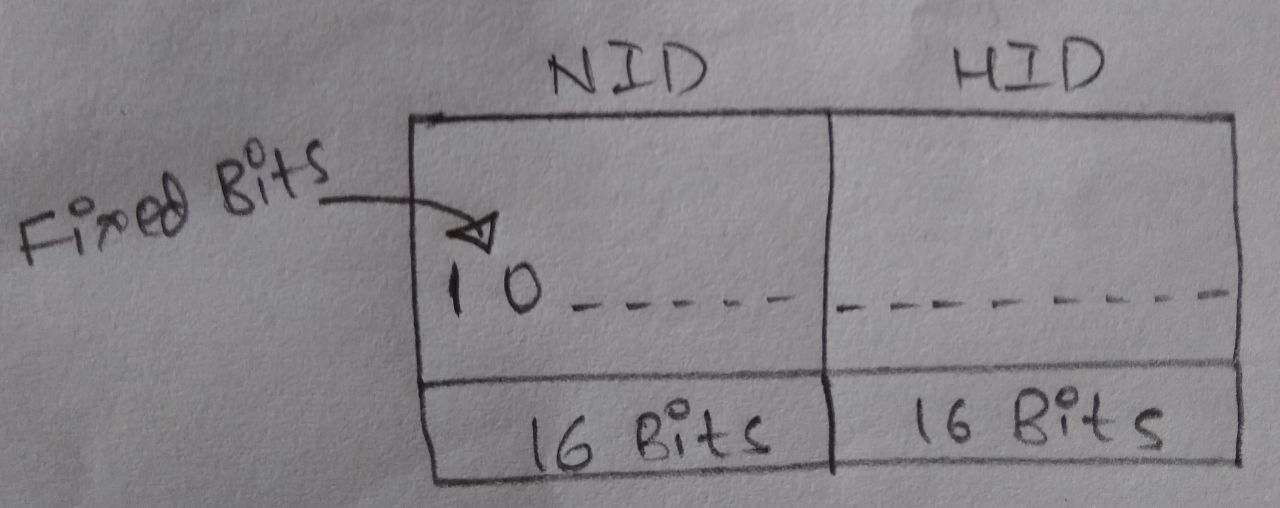
first octet first two bits set to 1 0 with remianing avialble bits in nid is 14 total networks of class b : 2^14 totals no. of hosts/network: 2^16 we can configure only 2^16-2 hosts/network
Range:
by seeing first octet if first bit is start from 1 0 in binary we can say it belongs to class b
so by examining first octet we can get range in decimal
1 0 0 0 0 0 0 0 - 128
1 0 0 0 0 0 0 1 - 129
1 0 0 0 0 0 1 0 - 130
.
.
.
1 0 1 1 1 1 1 1 - 191
range (128-191)
example ip addresses:128.0.0.0,128.0.0.1,…etc
this class b ipp addresses used for medium networks
Class C:
lets take remaining half from previous binary division and divide into two halves
1 1 0 0 0 0 0 0 . 0 0 0 0 0 0 0 0 . 0 0 0 0 0 0 0 0 . 0 0 0 0 0 0 0 0
1 1 1 0 0 0 0 0 . 0 0 0 0 0 0 0 0 . 0 0 0 0 0 0 0 0 . 0 0 0 0 0 0 0 0
lets take first half
1 1 0 0 0 0 0 0 . 0 0 0 0 0 0 0 0 . 0 0 0 0 0 0 0 0 . 0 0 0 0 0 0 0 0
for the binary division we took third bit which is set to 0,from prviously got binary number first 2 bits are fixed ,so now we got 110 as prefix which is fixed
first 3 bits are fixed ,remaining bits are 29,with 29 bits we have total addresses 2^29 in class c
NID,HID Division:
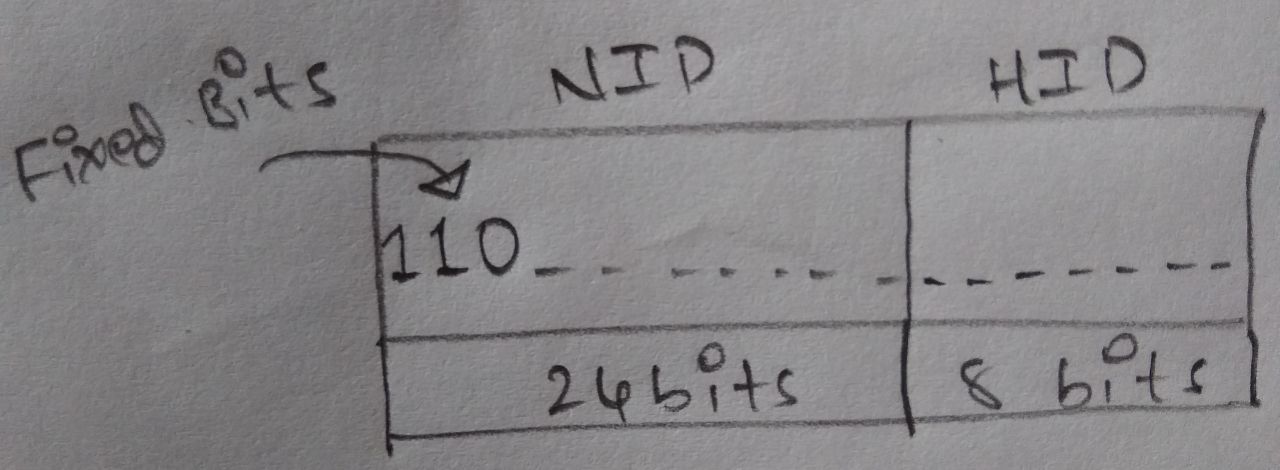
in network portion total we have 24 bits,but 3 bits are fixed cant change so finally we have 21 bits only. total networks:2^21 total hosts:2^8 we can configure only 2^8-2 hosts/network
Range:
by examining first octet we get range
1 1 0 0 0 0 0 0 - 192 1 1 0 0 0 0 0 1 - 193 1 1 0 0 0 0 1 0 - 194 . . . 1 1 0 1 1 1 1 1 - 223
range (192-223)
this classc ipp addresses are used for small networks.example home network,small office…etc
class a,b,c are used for hosts
Class D:
we got this below from previous binary divisio
1 1 1 0 0 0 0 0 . 0 0 0 0 0 0 0 0 . 0 0 0 0 0 0 0 0 . 0 0 0 0 0 0 0 0
divide the above binary data into two parts,by taking 1 bit
1 1 1 0 0 0 0 0 . 0 0 0 0 0 0 0 0 . 0 0 0 0 0 0 0 0 . 0 0 0 0 0 0 0 0
1 1 1 1 0 0 0 0 . 0 0 0 0 0 0 0 0 . 0 0 0 0 0 0 0 0 . 0 0 0 0 0 0 0 0
NID,HID Division:
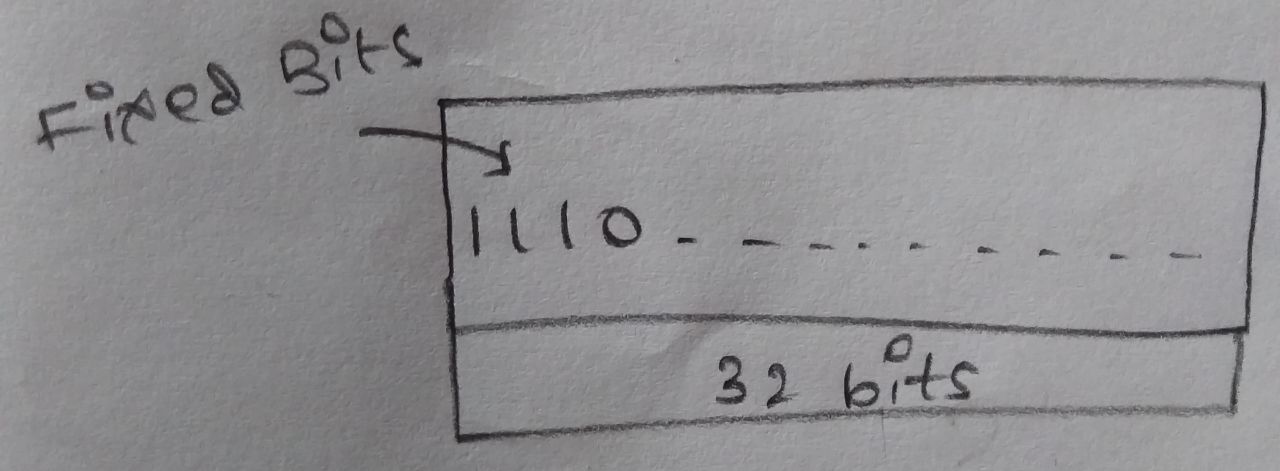
there’s no nid,hid part in classd,addresses uses as it is as whole
total number of ip addresses we get :2^28
Range:
1 1 1 0 0 0 0 0 - 224
1 1 1 0 0 0 0 1 - 225
.
.
.
1 1 1 0 1 1 1 1 - 239
used for multicasting
Class E:
lets take remainng half from previous binary division
1 1 1 1 0 0 0 0 . 0 0 0 0 0 0 0 0 . 0 0 0 0 0 0 0 0 . 0 0 0 0 0 0 0 0
NID,HID Division:
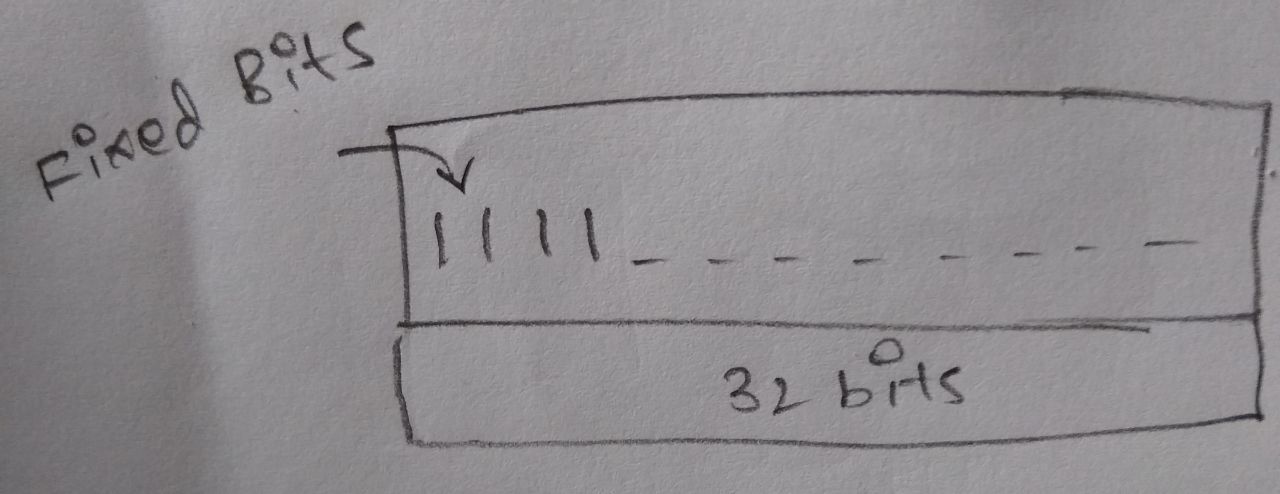
there’s no nid,hid part in classd,addresses uses as it is as whole
total number of ip addresses we get :2^28
Range:
1 1 1 1 0 0 0 0 - 240
1 1 1 1 0 0 0 1 - 241
.
.
.
1 1 1 1 1 1 1 1 - 255
range (240-255)
this ip’s are reserved